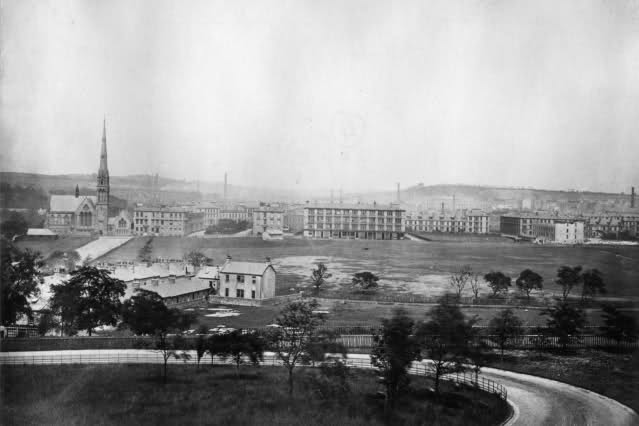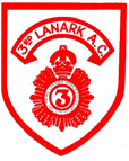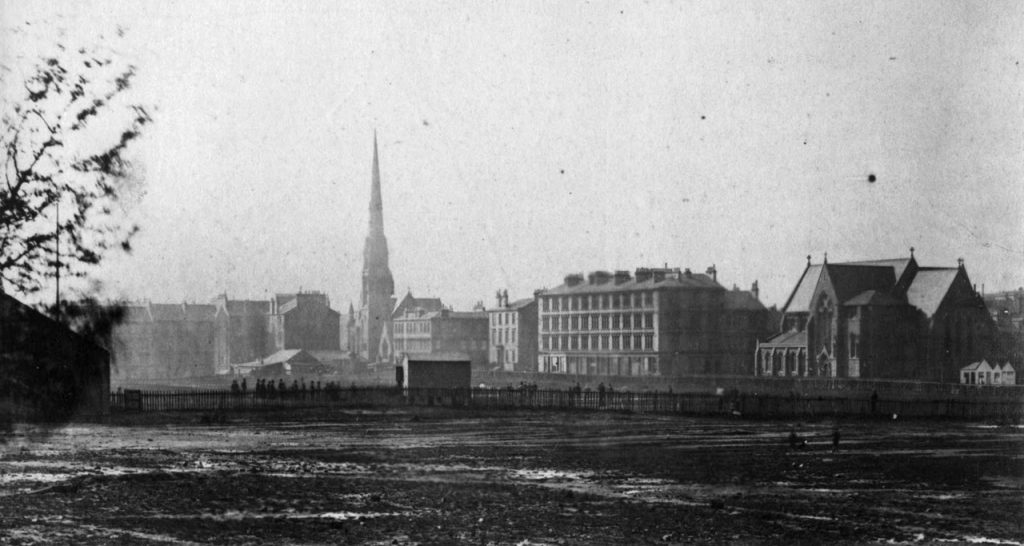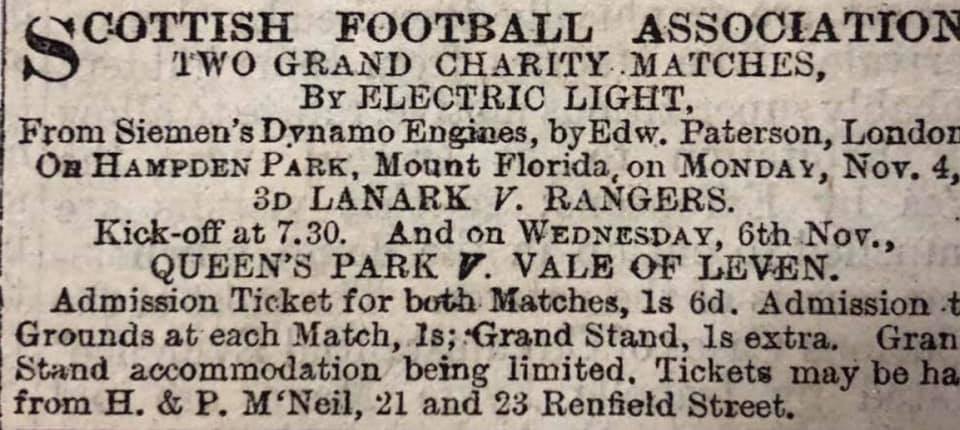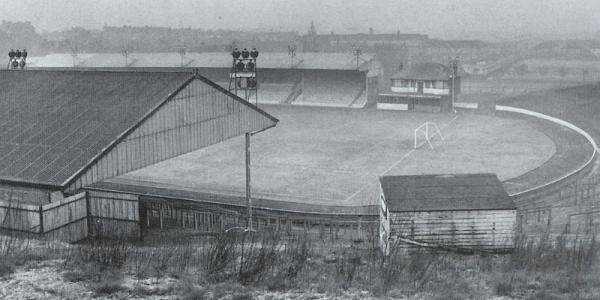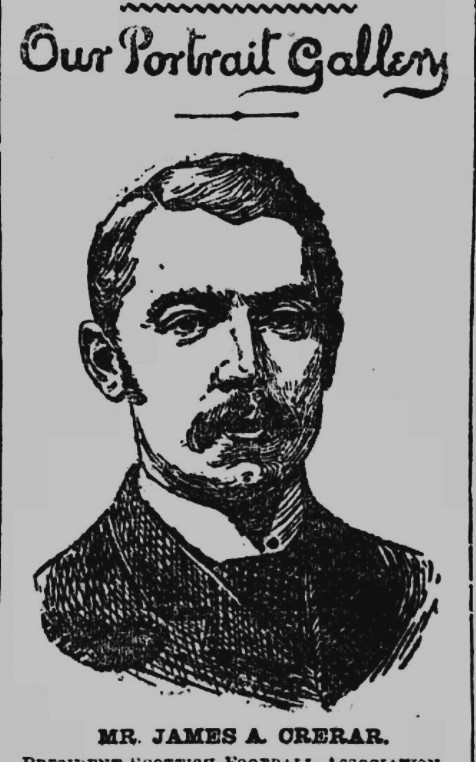Burnbank Grounds from Part Circus
Not all sports organised by football clubs in the nineteenth/early 20th century were he same. They all entertained the public in their thousands but the content was different. For instance Rangers, Celtic and Queen’s Park were all amateur sports and attracted Olympic, European and the best of Scottish as well as having many handicap events for local athletes. Clyde FC on the other hand held purely professional sports meetings, as did the Glasgow Police AC. But the Lanark Rifle Volunteers were different from both. It has proved to be difficult to follow their version of a summer sports meeting for several reasons:
- they are not covered by the Press nearly as much as the others, and the trail is difficult to follow. There are not many photographs or line drawings either;
- the trail is obscured by the size of the Volunteer movement. In addition to Third Lanark, there was 1st Lanark and regiments up to the 105th Lanark. Athletes were as lik ly to be attributed to the simple LRV as to any single regiment.
- later the 3rd LRV did not have either cycle races or running races at their meetings and so could not be sports meetings. The chosen descriptor was carnival.
So rather than follow the sometimes unclear, sometimes invisible Third Lanark Sports, we will simply illustrate the athletic activities of the Lanark Rifle Volunteers wherever the trail takes us.
Third Lanark RLV had been taking part in athletics, as well as a range of other sports, for over a decade when the SAAA was founded in 1883. The Athletics Club was formed in the Regimental Orderly Room, East Howard Street, Glasgow on 12th December 1872. The Third Lanark website, www.third-lanark.com , tells us that:
“The first Scotland v England football international at Hamilton Crescent, Glasgow in 1872 inspired the regiment to start a football team of their own, subsequently becoming one of the original members of the Scottish Football Association. A meeting was duly advised by the intimation of a public notice on the 12th December 1872 by members of the 3rd Lanarkshire Rifle Volunteers and the meeting was convened in the Regimental Orderly room in East Howard Street, Glasgow. Private Broadfoot explained that the meeting was called for the purpose of organising, if possible, a Football Club in connection with the Third Regiment. He further reported that Lieutenant-Colonel H E Crum-Ewing, the majority of the Officers and twenty-five other members of the Regiment had signified their willingness to support such a club.”
The club had many members who took part in athletic sorts meetings and they appear in the results from meetings as far afield as Edinburgh, the Borders and various Highland Games, as well as in both professional and amateur meetings. They clearly held some meetings of their own since they were referred to in later publications. The 1st Lanark seem to have been most assiduous of the LRV regiments in holding proper amateur athletic games.
Ir is not clear when the first proper athletic meeting was organised by any of the Lanark Volunteers but on 29th May, 1875, there was a typical sports meeting of the time. It was held at Burnbank Grounds (above), and was ‘a promenade and annual sports organised under the auspices of the 1st LRV’. The weather was good, there was a large crowd, and it was a successful meeting with flat races, field events (cricket ball and high leap), races confined to members of the regiment and open races. There was also a steeplechase run from Burnbank Park, over palings and hedges to the flagstaff in the West End Park and back. First man home was disqualified for failing to take the last paling, preferring to take the extra distance and run through the gate. The races included a 100 yards race, a 220 yards, a quarter mile (open to amateurs), half a mile, 120 yards hurdles (open to amateurs), one mile (open to amateurs), sack race, and steeplechase. A high leap (open to amateurs), vaulting with the pole (also open to amateurs), broad leap (open to amateurs) and throwing the cricket ball (open to Amateurs). All races not specified were open to members of the regiment or confined to members of the regiment and in some cases there were separate races for amateurs or members of the regiment. This was more than ten years before there would be an open athletics meeting run by an open athletic club.
The link between the Volunteers and Glasgow Academy at Burnbrae should maybe be noted. The Volunteers was a massive organisation at the time and the shared the use of Burnbank with the Academy. It was situated on the south-side of Great Western Road at Barrington Drive, and was leased from the First Lanarkshire Volunteer Rifles hence the use for drill. The Glasgow Accies first president was H E Crum-Ewing who was also a founding father of Third Lanark possibly through the volunteer connection
There are several references to this joint activity in the Press at the time: eg The Glasgow Herald of 6th June 1881 refers to “At a meeting of the Directors of the Glasgow Academy permission was granted for this company (The Hillhead Company of the Glasgow Highland Division of the Rifle Volunteers to drill in the playground of that institution.”
The cutting dates from 1897. At the time Third Lanark FC was one of the best known in the land. Formed shortly before the Rangers FC and also hailing from the south side of Glasgow they kept up with all the modern trends: Was this the first floodlit football match in Glasgow – or even in Scotland?
There are many instances of members of both 1st and 3rd Lanark taking part in open meetings. For instance in 1877 on 11th June at the Greenock Sports: WR Kirk 1st LRV won the half mile and in the one mile race he was part of a dead heat for second. At Dumbarton FC Sports on 7th June, 1881 Alex McNab 3rd LRV second in 100; 31st May, 1882 at the Alexandra Athletic Club meeting, T Dingwall (limit man) of 3rd LRV won the Mile Handicap from a mark of 130 yards. Later at the same meeting he was second in another Mile Race for the Warwick vase. This race had been won previously by A McCorkindale of 1st LRV. The most prolific racer and prize winner however was J Crerar of 3rd Lanark. In the Parkgrove FC Sports in August 1879 he was second in the quarter mile and unplaced in the final of the 100 yards, having won his Heat; in the Queen’s Park Sports of 1880, running from scratch in the 100 yards, he won his Heat and was third in the final, he won the 120 yards hurdles and dead heated for second in the quarter mile. He just seemed to go on racing successfully – open races or races confined to the LRV members, 100, 220 440 or hurdles, high jump or long jump he did them all.
Cathkin Park
On 6th June, 1881 3rd Lanark Rifle Volunteers Sports were held at Cathkin Park but results of this meeting are not to hand.
On 11th June, 1881 the amateur athletics fixtures for July and August were published and on August 13th, at Cathkin Park, the 3rd LRV Regimental Athletic Club Sports and Promenade were scheduled to take place. The report in the ‘Glasgow Herald’ of 15th August said:
“3rd LRV Regimental and Clubs Athletic Sports
The first annual athletic sports in connection with the 3rd LRV Regimental and football club took place on ??? grounds, Cathkin Park, Cathcart on Saturday afternoon. About 3000 spectators were present although the attendance was not so large as might have been expected from the nature of the gathering. The sports were under the patronage of the Lord Provost and Magistrates of Glasgow. Among others present were Colonel Merry. Major Wilson, Captain GM Wilson, Captain McCloy, Captain Hallcoat, Lieut JB Wilson, Lieut ?? McLaren, Lieut Hamilton, Capt John Cassels, Mr John J Murray, Mr Jas Taylor jnr, Mr J Wallace, Mr Crerar. ”
Events on the day included Half Mile Handicap (confined); 120 yards hurdles race (club and regiment_; 100 yards race (open); 100 yards regimental race; four-a-side football; one mile bicycle race; One mile race (open); tug of war (regimental and club); 100 yards members handicap; quarter mile race (confined to regiment); sack race (club and regiment); quarter mile handicap (confined to regiment); quarter mile handicap (confined to members); obstacle race (open); quarter mile race (open); 220 yards consolation race. An interesting comment after the event at the prize giving came from Colonel Murry who looked upon the South Side as the cradle of athletic sports ie Queen’s Park, the Rangers, 3rd Lanark and other famous clubs.
This event was one week before the Rangers FC held their own first annual sports.
10 days after the meeting, the following sour-faced article appeared in the”Glasgow Evening Post” of 20th August 1881:
“Athletic Jottings”
I am always sorry to see the word ‘failure’ written upon anything connected with athletics. This cannot exactly be be said of the sports of the 3rd Lanark LRV on Saturday, though if they were not a failure they were not exactly a success. The weather was everything that the most captious could wish, the sun shone and all things which are supposed to favour athletic meetings were in the ascendant, and yet the public did not patronise the sports at Cathkin Park on Saturday last. The reason is not far to seek. People do not care to see a lot of confined races in which no one is interested by the competitors themselves. No known man is performing, and the whole affair is a scramble. It was a mistake for the club to connect itself with the regiment. If it had gone to work on its own account, it might have been more successful. However “experientia docet”and if it should venture again into the athletic world, I have no doubt that it will be having this experience to guide it in the future. The club will see that there is something else required than the getting up of any programme and opening its gates to induce the public to come in. What is more, the prizes for the open events were no great shakes, and the entries were received in proportion to the value of the articles. Almost in all cases the names sent in did not exceed half a dozen and the fields were necessarily very limited, and the competition, with the exception of the hundred yards, which was a very good race, very tame indeed. All the valuable prizes were confined to the regiment, for which I am led to believe the Committee are not responsible. as in most cases the donors, who were principally officers of the regiment, stipulated that they should be confined. The result was unfortunate but they will know better next time.”
*
31st May, 1882 at the Alexandra Athletic Club meeting, T Dingwall (limit man) of 3rd LRV won the Mile Handicap from a mark of 130 yards. Later at the same meeting he was second in another Mile Race for the Warwick vase. This race had been won previously by A McCorkindale of 1st LRV.
*
The ‘Glasgow Herald’ of 2nd June 1884 had a lengthy report on Military and Athletic Sports at Burnbank under the auspices of the 1st Lanark RV. The weather was of the ‘most enjoyable sort for outdoor proceedings and several thousands of spectators turned out to witness the sports which were thoroughly successful. ‘ The card was described as an extremely varied and interesting one and contained events confined to members of Her Majesty’s Forces including auxiliaries, confined events open only to members of 1st LRV and open events to which all amateurs were free to compete. Confined events included 100 yards race, three legged race, sack race, monkey race, one mile race and drop kick; open events included 100 yards, mile and hurdles. But the most interesting part of the programme was the military part, reported the Herald, which included purely military events such as tent pegging, tug of war, heads and posts, tilting at the ring, silent ride and lemon cutting. The Scots Greys and Royal Artillery (mounted) came from Maryhill and ‘showed considerable skill with lance and sabre.’
There were 24 events on the programme on 13th September in 1884 when the 10th LRV held their sports at Burnbank in weather that was ‘of the most pleasant’ There were more field events than was usual at the other sports meetings held in and around Glasgow: Running hop, step and leap, the running long leap, high leap, putting the light stone, putting the heavy ball, throwing the heavy hammer and tossing the caber all took place alongside a full programme of running events plus dancing and military drills such as cutting the lemon, field gun driving competition, wrestling on horseback. There were confined events to Volunteers, to non commissioned officers, to heads of companies and, of course, open events.
The 1st LRV held their sports meeting a year later, on 30th May in 1885, again at Burnbank Grounds, Great Western Road, Glasgow. Remember that at that time Glasgow was part of the County of Lanarkshire. The report in the ‘Sporting Life’ of Tuesday, 2nd June, tells us that the weather was ‘pretty good’ although wind got up as the afternoon progressed, the field was in ‘pretty nice condition’ and a ‘large and fashionable gathering of spectators lined the ropes.’ It was well supported by the athletes too with names like JR Gow and A Vallance of the Rangers FC competing. There were 14 events on the programme, several with heats involved – eg the 100 yards had 3 heats, the 100 yards handicap open had 7 heats, the quarter mile 4. There were sprints (120 hurdles, 120 open handicap hurdles, 440 yards mile handicap), middle distance races (half mile handicap, 1 mile open), there were novelty races (wheelbarrow race, obstacle race, sack race), bicycle races and ‘sort of’ field events (Drop kick and cricket ball throw). All the major football clubs, and some of the lesser, were represented (Rangers, St Mirren, Lanark RLV, Battlefield FC, West of Scotland FC), as were the Universities (GUAC and EUAC). All in all it seems to have been a good day’s sports. Although it was still before the establishment of open amateur clubs, it was described as “the annual sports promoted by the athletic club of this popular corps”, so the public appetite was there for athletics meetings and the LRV had been promoting them.
Meanwhile away from the football field, Clydesdale Harriers, the first open Scottish athletics club, was founded on 4th May, 1885: and their first ever track competition was held over 300 yards with 54 entries. Of these only 36 ran; there were seven heats, semi-finals and final on the same evening at Kinning Park. The event was a great success and the winner was CJ Rattray of the 1st Lanark Rifle Volunteers from H McHardie, Clydesdale, J Cherrie, Clydesdale, and GT Ward, Partick Thistle.. He won in 33 seconds. The first race organised by an open athletics club in Scotland was won by a man from the 1st LRV.
The 1st Lanark Sports were again held at Burnbank Grounds on 28th May 1886. Clydesdale Harriers were well represented at the meeting, as were the Universities, the football clubs (the numbers from the previous year added to by Pilgrims FC, Craigielea FC, Dumbarton Athletic FC and Vale of Leven FC) and several unattached runners.. Events were largely as the previous year except for the addition of “Heads and Posts (Mounted)” which was contested by members of the 4th Queen’s Own Hussars. It was a success but there were bigger numbers at the Edinburgh Harriers Amateur Sports held at Powderhall. Edinburgh Harriers were the second of the amateur athletic clubs to be set up in 1886. Maybe we should note the absence of five-a-side football from these Sports.
The meeting above was very clearly an amateur meeting but there was another called the ‘ Tenth Lanark Volunteers Annual Sports, also at Burnbank, held on 21st August which was restricted to members of the regiment with a few races open to professional athletes. It was a short programme and very varied with a strangely named ‘Lemon Cutting’ which was won by a Hussar so it may well have involved sabres and horses!
*
That there were still members of Third Lanark who were keen athletes is maybe shown by this article that appeared in the “Scottish Umpire” of 30th November 1886:
“Apologies to C.H. The “Scottish Umpire” had said after a footballing defeat that the Clydesdale had more to learn about football than about running. They were taken to task for this and published the following list from among the members of the C.H. Goal: Phillip (Pilgrims); Backs: Gow and Vallance (Rangers), Cherrie (QP); Half backs: Gow (QP), Auld (3rd LRV), Cameron and McIntyre (Rangers); Forwards: Marshall and Thomson (3rd LRV), McKenzie and Gow (Rangers), Cleland (Cowlairs), Allan (QP).” It should be noted that Auld, Marshall and Allan were all capped for Scotland 14 days later. Scottish international football players who were interested enough to joing a specialised athletic club.
There is often a moving spirit in the development of any sports club or section and in this case it might well have been James A Crerar. He had been President of the club before becoming President of the SFA in 1888 having joined Third Lanark in 1875. Although he was a football player to start with he was also a considerably good athlete and the Scottish Referee (3rd December 1888) tells us that “As an athlete Mr Crerar’s record is worthy of honorable mention. In distances from 100 yards to the half-mile he gained distinction. His best performance was the quarter in which he gained 12 first prizes. He beat at his favourite distance WW Beveridge, in his day one of our fastest sprinters. Notable events too in his career were were his defeat twice in the half of JD Finlayson , a runner who may be remembered for his excellent record in the Mile. In the heavy items such as hammer throwing and shot putting Mr Crerar had few equals. Altogether his total list gives 56 prizes. This represents athletic powers far above the average, and well entitles their possessor to a first place in the ranks of Scottish athletics.”
He was indeed a very good athlete who competed in the late 1870’s and the start of the 80’s. He competed often and was well known in Glasgow. eg at the QPFC Sports in September 1878 he ran in the 440 yards where he was second in his heat of the 440 yards handicap, and second in the Final; June 1879. Alexandra Athletic Club Sports, half mile handicap, 1st; at Ardrossan, July, 1879 second in 220, second in 440; at the Parkgrove Sports in Trinidad Park, Copeland Road, in Glasgow on 23rd August 1879 he was second his heat of the 440 yards open handicap and third in the Final (where the winner was WW Beveridge), then was third in his heat of the 100 yards handicap but unplaced in the final. He ran in the 3rd Lanark colours although at the QPFC Sports he was noted in the ‘Glasgow Herald’ as being for the host club: possibly a typo.These events were chosen indicate his range with prizes wo at 100, 220, 440 and 880 yards.
*
23rd May 1889, Upper Lanarkshire Examiner, “The officers of our local volunteers some time ago obtained the lease of the Clydesdale Hall in the Main and second in the Final; Street for the purpose of using it as a drill hall and gymnasium, and on Tuesday the formal opening took place in the shape of a grand gymnastic entertainment, given by a party of gentlemen belonging to the 3rd LRV Athletic Club under Sergeant-Instructor Clark. The hall ….. has been fitted up with a complete set of gymnastic appliances consisting of ladders, horizontal and parallel bars, rings and trapeze, while a large number of bar bells and dumb bells, Indian clubs &c have been provided.”
On 1st June 1889, the 1st LRV held a sports event at Burnbank Grounds with flat races, both open and confined and cycle races, Running events included 100 yards (open event had seven heats, semi finals and final), 220 yards (six heats), quarter mile, (four heats), half mile, mile and three miles with a fair sprinkling of national champions and record holders such as JR Gow, J Wright and J Blane.
Later that year, on 24th August 3rd LRV had a confined meeting at Cathkin Park and they were reported to be of a ‘very jolly character’. There were running events and a 5-a-side football tournament. We know that this meeting took place – but it is not covered in the Glasgow Herald, either in the athletics column nor in any of the three Volunteers columns.
*
The Scottish Referee of 2nd July 1894 had this short preview of the annual sports: “Third Lanark have an amateur and professional tourney on similar lines to that of the Celtic on Cathkin Park, on Saturday first. Queen’s Park and all the leading League clubs have entered, and the play therefore should be of a first class order. The prizes of course will b in kind and not in money, and are a valuable lot. In addition to the football the public will of course gain admission to the Carnival a show in itself worth all the money (sixpence) asked. Besides the serious football, two teams of non descripts will play in fancy costumes, and we shall have a Tel-el-Kebir five a side with the sodger and the sailyor chasing the ball. A side splitting entertainment it will be, to be sure – so be there.”
This sounds more like a football day out than a sports.
27th July 1895 was the due date for the Third Lanark Sports, and the ‘Scottish Referee’ had this to say: “The Third Lanark FC Sports which took place at Cathkin Park on Saturday afternoon were quite a success, though the unfavourable weather took a toll on the attendance. The programme was an admirable one and the procedings were admirably conducted. The gymnastic club in connection with the regiment gave some very clever displays on the horizontal bar, while the musical and bayonet exercises by the Gordon Highlanders were probably the leading features in an afternoon’s sport. The Thirds sports are now recognised as a sort of introduction to the football season, and on account of the variety of entertainment which they afford are looked forward to with pleasure.”
The ‘Glasgow Herald of the same date gave more information on the content of the programme – wrestling on horseback, and a five-a-side competition with Rangers, Clyde, Third Lanark, Linthouse, Hibernian, Partick Thistle and Motherwell. The organisers in cluded the afore mentioned JA Crerar and a note was made that the football was not a great success.
But if we fast forward a year or so we see that Thirds actually stepped back from amateur athletics such as those run by most clubs or even the professional athletics organised by Clyde FC. The sports of 1896 were cancelled late in the day but the comments contained in the Press indicate that they maybe did not take the athletics aspect too seriously. From the Glasgow Herald of Monday, 27th July, 1896:
“Rain fell copiously on Saturday and all the leading athletic events down for decision had to be declared off. The Third Lanark FC Committee held out as long as possible before coming to a decision. At one time in the afternoon there was just the prospect of the rain clearing away, but by the advertised time of starting it came on again and, despite the presence of a number of competitors and the public, there was nothing for it but to declare a postponement till the 5th of next month. Unfortunately this will clash with another important meeting in the city, but as the sports under the auspices of the Volunteers are outside the pale of ordinary club gatherings, they will doubtless be accorded a good measure of support.”
The phrase about the sports being ‘outside the pale of ordinary club gatherings’ is an interesting one and is perhaps qualified by the underlined section of the preview of the 1897 meeting below.
23rd July 1897, Scottish Referee, looking forward to the Saturday Meeting at Cathkin: “The Third Lanark’s tournament has now become a thing of perpetuity, and year after year is increasing in popularity. Unlike other big clubs, the Warriors do not indulge in cycling and flat race running. On the contrary, theirs is a meeting peculiarly their own, and none the less interesting because of that. Cathkin being devoid of a cycling track, the Volunteer Committee in the past had to search for other pastimes to entertain their patrons and, under the guiding hand of Major Wilson, they succeeded in introducing novelties that were at once interesting, amusing and instructive; in fact, the Gay and Gallant Gordons were seen by many on Cathkin who would never otherwise have had the privilege of witnessing the hardy Highlanders go through the scenes of physical drill and other manoeuvres that were stamped on the minds of those who saw them.”
An interesting start to the preview of the Games and maybe a reason for the absence of the ‘tournament’ from the sports pages. It went on to say that there would be a senior 5-a-side football, a tug-of-war with several clubs competing, a gymnastic exhibition by the 3rd LRV, a 100 yards handicap confined to footballers, the Argyll & Sutherland Highlanders with their full pipe band and drummers and a ‘mimic battle’. The football tournament would include the ‘Light Blues’ and the ‘Maroons’, the ‘Bully Wee Clyde’, the Hibs, the Partick Thistle, the St Mirren and the Motherwell. An entertaining afternoon, events started at 3:00 pm, but not athletics as we know it! In fact the Third Lanark Sports as described do not fill the bill for aficionados of running, jumping or throwing.
The ‘Dundee Courier’ reported on 26 July, 1897, on the meeting under the heading THIRD LANARK FC SPORTS which began as follows:
“These annual sports held at Cathkin on Saturday afternoon attracted an audience of 7000 spectators. The programme was of a varied and interesting character and for the first time there was introduced a 100 yards flat race handicap open to professional football players.” It covered only three events – the footballers 100 yards, the 5-a-sides and the tug-of-war’ By having the football players race open to professional players, many of the fastest men were unable to take part since they were competing in amateur athletics.
That these sports of 1897 were not a deviation from the norm, is indicated by the preview in the Scottish Referee of 1st July, 1898 which again emphasised the absence of track and field athletics and read:
“THE THIRD PREPARING.
The Third Lanark Committee are making preparations for their annual carnival, which is to take place on the last Saturday of the present month. Since the Warriors followed in the footsteps of the majority of other class clubs by holding annual sports they have met with unfailing success. Unlike their football colleagues however, the Third have provided an entertainment peculiarly their own yet decidedly entertaining and attractive. This season it is the intention of the promoters to continue outwith the pale of the beaten track of cycling and flat running, and with a programme arranged to suit the palates of the public in general, and footballers in particular, they anticipate that another successful meeting will result. The professional five-a-side competition will certainly create a considerable stir, as it will give many the opportunity to see again the ‘dribbling demons’ tripping hither and thither after the ball in all their old elasticity. A junior tourney is also in the process of being arranged and as usual the military from Maryhill will show their work as warriors true in drilling, bayonet exercise, physical drill and other manoeuvres. Several interesting titbits are in view and when the programme is issued it will be seen to be one of the best. The very novelty of the sports will have a magnetic effect on the multitude.”
Without criticising the content of the sports in any way whatsoever, the meeting was not an athletics meeting like those of Queens Park FC, the Rangers FC, Celtic Fc or St Mirren FC. There is enough here to show what the club could have been in terms of athletics success and the results achieved by their athletes wete at time quite superb. What is manifest however is that the Thirds Sports were not at all athletic events as such. This does not mean that there were no athletics meetings held at Cathkin Park. Far from it, but these were held by organisations other than the football club. For instance the Glasgow Police Sports which was a major meeting right up into the 1950’s is associated with Ibrox Park but they were held at Cathkin for several years – eg in June 1897 they were at the Thirds ground and included running events, field events such as high jumping, pole vaulting as well as piping, dancing and tug of war. Glasgow University held their Sports there in June 1906 as preparation for the Inter-Varsity Sports. Thirds themselves had their five a side football tournament at the end of August and they were very successful too but as for open athletics – not organised by them.
The original venue which hosted these events was abandoned in 1903 when the club moved to the old Hampden Park. Queen’s Park moved from this facility to one more suited to their needs and Thirds moved in. To change or not to change? The name that is. The following cutting from the ‘Scottish Referee’ is relevant:
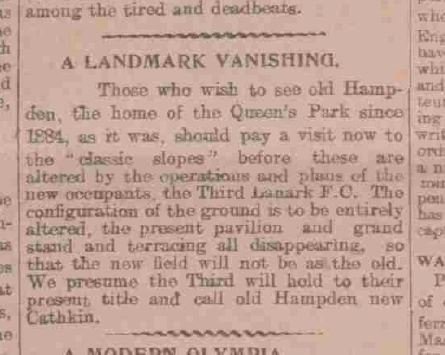 And they did just that: Old Hampden became the new Cathkin Park.
And they did just that: Old Hampden became the new Cathkin Park.
